Working with the VRED Renderer in Alias
![]() +
+ ![]()
VRED Renderer in Alias provides enhanced viewport visualization, which uses the same Vulkan Rendering technology as the VRED product line. With VRED rendering, you can assign, edit, and create VRED Truelight materials, which are included with Alias, and MaterialX materials. You can also assign MDL, X-Rite, and Substance materials. VRED Rendering in Alias gives you a consistent visual look and feel with VRED, which is particularly useful when using Live Referencing in your visualization workflow.
For more information about accessing MDL, X-Rite, and Substance materials, see MaterialX and MDL and Working with Web Shops in the VRED Help.
Like Alias Hardware shading, you can access VRED Rendering and VRED material options using these windows and editors:
- Hardware Shade - Note that you can access VRED specific Render Settings, such as Ambient Occlusion, Tone Mapping, and Depth Peeling from the Hardware Shade window by selecting Rendering Settings.
- Shader Lister
- Shader Editor
- Shader Library
- Environment Editor
Alias and VRED render modes
When you create a new shader or material, Alias generates render mode specific versions of the render asset. For example, when you create either a new Alias shader or VRED material, the asset has both Alias shader attributes and VRED material attributes. So, when you assign the shader or material to geometry, it has representations of both Alias and VRED render modes. When in VRED Render mode, the material attributes of the asset are used. When in Alias Render mode, the shader attributes are used.
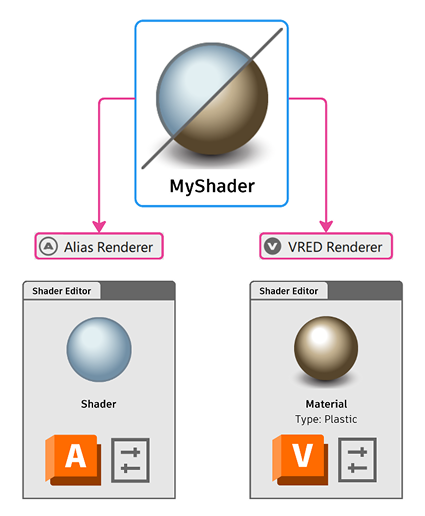
If you open a file created in a version of Alias previous to Alias 2026, then switch to VRED Render mode, the assigned Alias shaders are converted to VRED materials. By default, these materials display with VRED plastic materials attributes. The shader names and colors are preserved, and the shaders now display VRED icons ![]() to indicate they are now VRED materials.
to indicate they are now VRED materials.
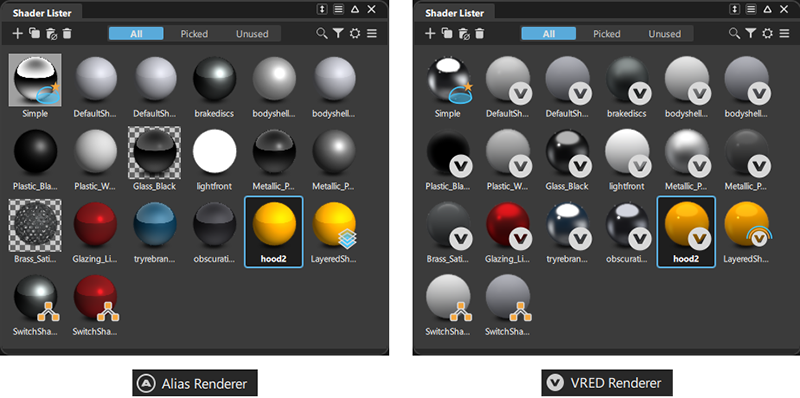
Alias also converts any Switch or Layered shader created in Alias render mode with VRED equivalents: Switch materials and Multi Pass materials respectively. If you create Multi Pass or Switch materials, then switch to Alias Render mode, the conversion does not occur in the opposite direction.
Switch from the Alias Render mode to the VRED Render mode by selecting VRED Renderer from the list in the promptline action bar.
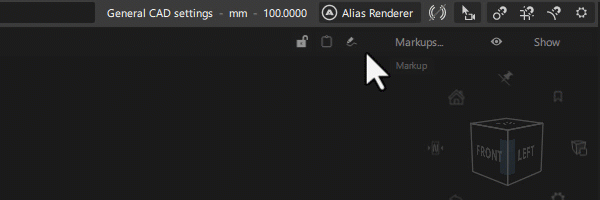
After turning on Hardware Shade (Shade On), your models now render using the VRED-based Vulkan renderer.
Using VRED Rendering in Alias
When determining how best take advantage of VRED Rendering in your existing visualization workflow, consider these typical scenarios:
Keep using Alias shaders and modify the VRED materials equivalents
If you plan on using Alias Render mode to visualize your model, you can modify the VRED material attributes to match the look of your existing Alias shaders.
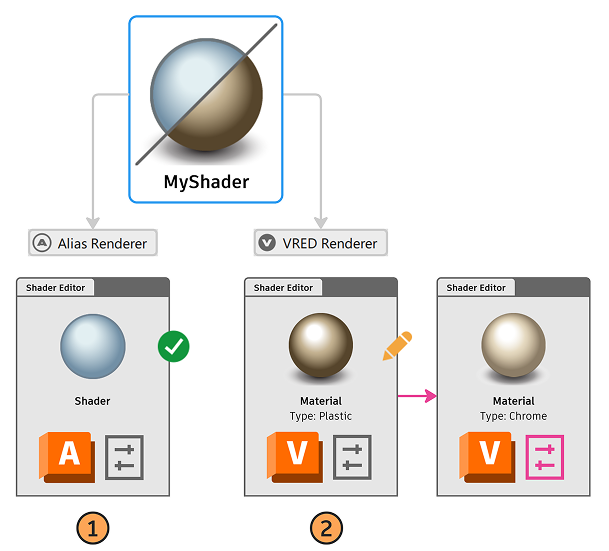
 - Keep your Alias shaders and their assignments.
- Keep your Alias shaders and their assignments.
 - Switch to VRED Render mode, then modify the attributes of the VRED material equivalents in the Shader Editor to get the same look as your Alias shader or any other desired look. This includes changing the default Plastic to another material type, such as Metallic Carpaint. In this scenario, editing the material attributes does not change the Alias shader attributes.
- Switch to VRED Render mode, then modify the attributes of the VRED material equivalents in the Shader Editor to get the same look as your Alias shader or any other desired look. This includes changing the default Plastic to another material type, such as Metallic Carpaint. In this scenario, editing the material attributes does not change the Alias shader attributes.
Replace Alias shaders with VRED materials
By default, Alias provides a library of VRED-based Truelight materials that you can use to replace your Alias shaders. When you replacing Alias shaders with VRED materials, a new shader equivalent is created. When you switch to Alias Render, mode you will notice that the shader is now different than the original.
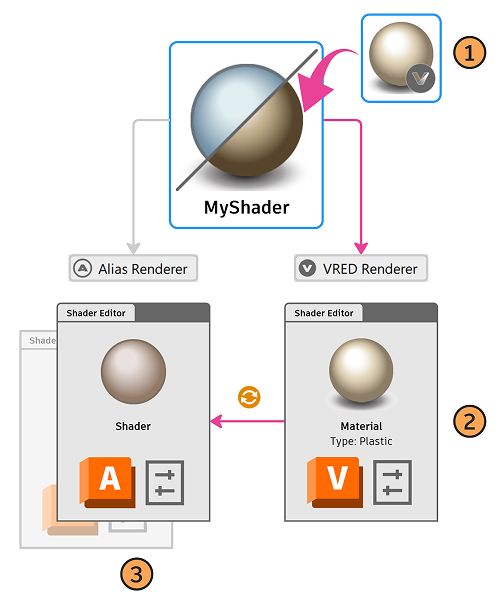
 - Switch to VRED Render mode, then drag a material from a VRED asset library onto the geometry to replace the previous assignment. You can also drag the material into the Shader Lister, then drag from there onto geometry to replace it, or drag the material onto the preview in the Shader Editor to replace the assigned material's properties.
- Switch to VRED Render mode, then drag a material from a VRED asset library onto the geometry to replace the previous assignment. You can also drag the material into the Shader Lister, then drag from there onto geometry to replace it, or drag the material onto the preview in the Shader Editor to replace the assigned material's properties.
 - The previously assigned VRED material equivalent is replaced by the incoming material.
- The previously assigned VRED material equivalent is replaced by the incoming material.
 - The Alias shader is automatically replaced by a new shader equivalent of the incoming material. When you switch back to Alias Render mode, you will notice that the shader is now different than the original.
- The Alias shader is automatically replaced by a new shader equivalent of the incoming material. When you switch back to Alias Render mode, you will notice that the shader is now different than the original.
Use materials from your custom VRED material library
If you are already using VRED in your visualization workflow, and have a library of custom VRED materials, you can quickly replace the existing Alias shaders with your custom VRED materials using MMB-drag. This way, your model appears the same in Alias and VRED, which is particularly useful if you are using Live Referencing.
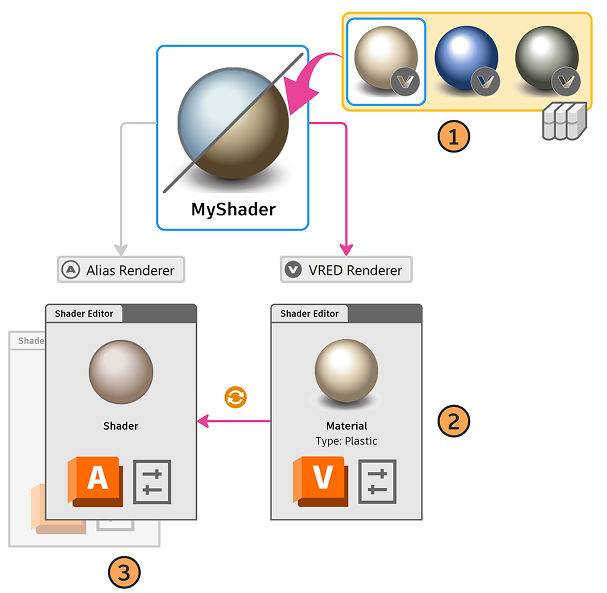
 - Load your custom material asset library into the Shader Library. Switch to VRED Render mode, then drag a material from your asset library onto the geometry to replace the previous assignment. You can also drag the material into the Shader Lister, then drag from there onto geometry to replace it.
- Load your custom material asset library into the Shader Library. Switch to VRED Render mode, then drag a material from your asset library onto the geometry to replace the previous assignment. You can also drag the material into the Shader Lister, then drag from there onto geometry to replace it.
 - The previously assigned VRED material is replaced by the incoming shader.
- The previously assigned VRED material is replaced by the incoming shader.
 - The Alias shader is automatically replaced by a new shader equivalent of the incoming material. When you switch back to Alias Render mode, you will notice that the shader is now different than the original.
- The Alias shader is automatically replaced by a new shader equivalent of the incoming material. When you switch back to Alias Render mode, you will notice that the shader is now different than the original.
Use shaders and materials from a custom asset library
If you plan on using both Alias and VRED render modes in your workflow, you can create a custom asset library that includes material and shader versions of each render asset. This way, you have versions of Alias shaders and VRED materials that are linked, and you do not need to update your previous shader or material libraries. The scenario below assumes that you've set the render mode to the VRED Renderer.

 - Open the Shader Library and LMB-drag materials to the Shader Lister, then double-click it to open the Shader Editor. Ensure that the Inactive Preview is on, so that you can see a small preview of the shader in addition to the material preview.
- Open the Shader Library and LMB-drag materials to the Shader Lister, then double-click it to open the Shader Editor. Ensure that the Inactive Preview is on, so that you can see a small preview of the shader in addition to the material preview.
 - Locate your Alias shaders in the Shader Library and drag it onto the Alias preview swatch in the Shader Editor.
- Locate your Alias shaders in the Shader Library and drag it onto the Alias preview swatch in the Shader Editor.
 - Drag the material to the VRED User Library or another custom asset library. The VRED material and Alias shader are now linked in an asset library.
- Drag the material to the VRED User Library or another custom asset library. The VRED material and Alias shader are now linked in an asset library.
Material Icons
VRED materials display different icons superimposed over their preview swatches to indicate their type and current state.
| Type | Icon | Preview |
|---|---|---|
| Material is in an assets library (linked) | ||
| Material is not in an assets library | No icon | |
| Being edited | ||
| Assigned to selected | ||
| Multi Pass | ||
| Layered | ||
| Switch | ||
| Empty Switch, Multi Pass, or Layered material | No icon | |
| MaterialX | ||
| MDL | ||
| Substance | ||
| X Rite | ||
| Unsupported material | No icon | |
| Environment |
Create Materials
By default, you can create custom versions of the VRED materials that are in the VRED Assets library. If you loaded MaterialX materials to a library, these can also be created. Some supported materials, such as MDL, Substance, and X-Rite materials, can be assigned but they cannot be created or edited in Alias.
Newly created materials are not linked to a shader or material library. You'll need to add this material to an asset library, such as the VRED User Library, by MMB-dragging it. This way, the material can be shared.
Open the the Shader Lister by selecting Visualization > Shader Lister.
In the Shader Lister, select the New icon
 , or Create Material from the More menu, then select the type of material you want to create from the list.
, or Create Material from the More menu, then select the type of material you want to create from the list.This creates that material and adds it to the Shader Lister.
Another way to create a material is to duplicate a material that already been added to the Shader Lister. Select the material, then select Duplicate icon:
 .
.
Modify Materials
If you assigned a VRED material from the VRED Assets library, you'll notice that the VRED material preview has a ![]() icon as well as a green link icon
icon as well as a green link icon ![]() . This indicates that this material is linked to the VRED Asset library.
. This indicates that this material is linked to the VRED Asset library.
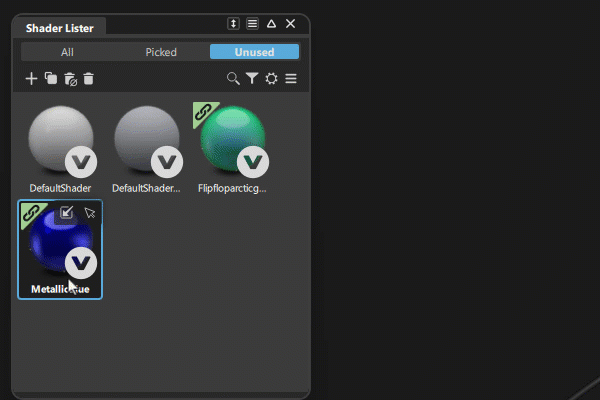
When linked, the material attributes cannot be modified, but you can choose from options:
Modify - Lets you modify the material attributes. You can then save them back to your materials library, such as to the VRED Assets library or a VRED User Library.

Remove Link - The material is no longer associated with the VRED Assets library that it originated from. It exists only in the current .wire file unless it is saved to another material library. Unlinked materials do not display a link icon.
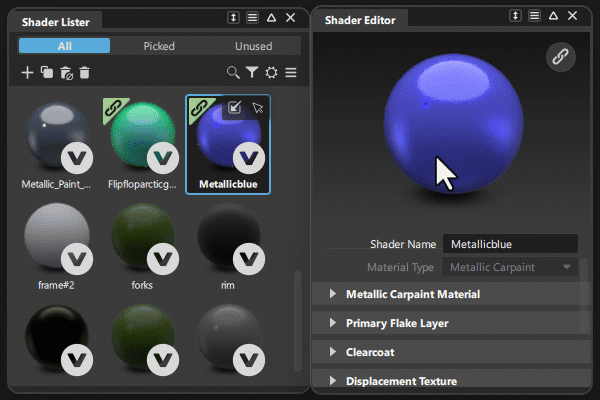
Reload from Shader Library - Discards any modifications you made to the material attributes and reloads the material from the library.
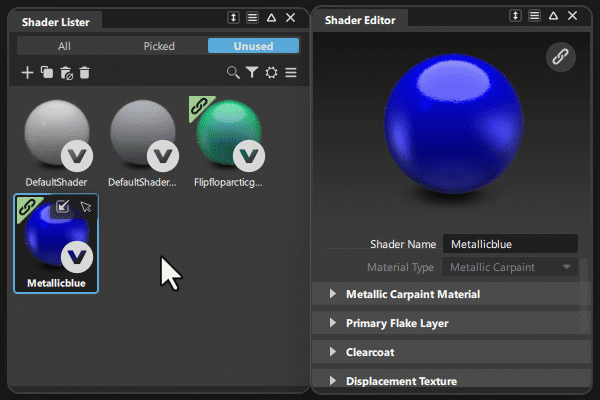
Assign Materials
You can assign VRED materials with the same methods used to assign Alias shaders.
Assign materials to selected objects
Select the Assign to Objects
 icon on material preview swatches. This option is available from the Shader Lister and Shader Library previews as well from as the Shader Editor icon bar.
icon on material preview swatches. This option is available from the Shader Lister and Shader Library previews as well from as the Shader Editor icon bar. Select Assign to Objects from the context menus in the Shader Lister, Shader Library, or Shader Editor.
Tip: This option is paired with Pick Objects icon in the Shader Lister and Shader Editor so you can easily select objects and assign a new material.
icon in the Shader Lister and Shader Editor so you can easily select objects and assign a new material.
Assign a material to a single surfaces
- LMB-drag the material from a preview swatch in the Shader Lister or Shader Library onto the geometry.
- LMB-drag the material from the shader preview in the Shader Editor.
Assign a material to all objects in a layer (Layer Bar or Object Lister)
- LMB-drag or MMB- drag the material preview swatch in the Shader Lister or Shader Library onto the layer.
- LMB-drag or MMB-drag the material from the shader preview in the Shader Editor onto the layer. Replace all surfaces sharing the same material with a new material
- MMB-drag material from the Shader Lister or Shader Library preview icon onto the geometry.
Create a custom asset library of linked materials and shaders
If you plan on using both Alias and VRED render modes in your workflow, you can create a custom asset library that includes material and shader versions of each render asset. This way, you have versions of Alias shaders and VRED materials that are linked, and you do not need to update your previous shader or material libraries.
You can start by creating either a VRED material or an Alias shader, then linking the other render asset to it. The scenario below assumes that you've set the render mode to the VRED Renderer.
Open the Shader Library and LMB-drag a VRED material to the Shader Lister, then double-click it to open the Shader Editor.
In the Shader Editor, click the Toggle Inactive Preview icon.
 to turn it on.
to turn it on.Now you see a small preview of the Alias shader equivalent in addition to the VRED material preview.
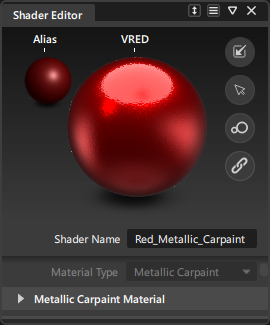
In the Shader Library, locate your Alias shaders you want to link to the VRED material, then MMB-drag it onto the Alias preview swatch in the Shader Editor.
The Alias shader is now linked to the VRED material.
Add the linked material and shader to an asset library, LMB-drag or MMB-drag the material to VRED User Library or another custom asset library (To create a new custom asset library, see Working with a Custom Asset Library).
The linked icon
 now displays in the Shader Editor, indicating that the material and shader equivalent are linked and part of an asset library. Note: If you do not add your linked material and shader to an asset library, they will only be saved to the current .wire file, meaning that they cannot be shared or used in a different file.
now displays in the Shader Editor, indicating that the material and shader equivalent are linked and part of an asset library. Note: If you do not add your linked material and shader to an asset library, they will only be saved to the current .wire file, meaning that they cannot be shared or used in a different file.
Now, when assigned to geometry, the linked material and shader are used for their respective renderers.
Delete or Rename Materials in an Asset Library
Deleting or renaming materials in a custom material library must be done using Windows® Explorer. Alias requires a restart to apply these changes. You cannot delete or rename materials in VRED Assets library that comes with Alias.
In the Shader Library, locate the material to delete or rename.
Right-click the material, then select Show in Explorer.
Do either of the following:
Delete the material's folder.
Rename all of the material related files in the material's folder.
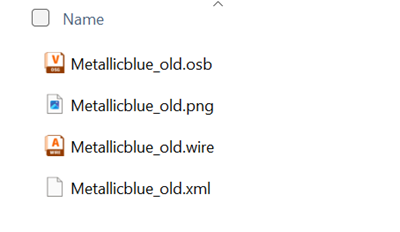
Restart Alias.
Working with Multi Pass, Layered, and Switch Materials
Multi Pass materials display multiple materials in different layers on top of each other. Use them to set up dirt, promotion labels, decals, and other types of complex materials. The order of the materials can be changed. Multi Pass materials behave the same way as Alias Layered shaders.
Switch materials can contain several materials, but only one of them is visible at a time. The selected shader in the list is the active shader, which is assigned to the objects the switch shader is assigned to. Select the other shaders in the list to make them active. Environments cannot be added to a Switch material. Switch materials and Alias Switch shaders behave the same way. Switch materials can include Multi Pass materials while Switch shaders cannot include Layered shaders.
Layered materials stack multiple materials on top of one another to handle multi-component materials, such as a tail light that has inner white glass and outer red glass, where these two glasses are melded together and share the surface between. Since there is no air or gap to handle the refractions correctly, Z-fighting becomes an issue, unless a layered material is used. Note that a Layered material does not behave the same as an Alias Layered shader.
Create a Multi Pass, Layered, or Switch Material
Multi Pass, Layered, and Switch materials are created in similar ways:
In the Shader Lister, click the New icon
 , then select either Multi Pass, Layered, or Switch from the list.
, then select either Multi Pass, Layered, or Switch from the list.A new material preview swatch appears in the Shader Lister. An icon on the swatch identifies the type of material you created:
 for Multi Pass,
for Multi Pass,  for Layered, and
for Layered, and  for Switch materials.
for Switch materials. MMB - drag the materials that you want to combine onto the new material.
Select the material to display it in the Shader Editor.
Each material you have added now appears in a list. The material at the top is laid down first.
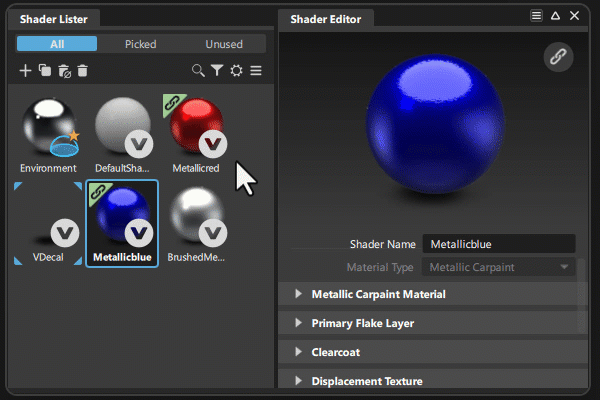
Note the following:
- Multi Pass materials display their materials in a different order than Alias Layered shaders. In a Multi Pass material,the materials display from the top of the list down. For example, if you want to display a decal image using a Multi Pass material, it must be on the bottom of the material list. Alias Layered shaders behave the opposite way.
- If the materials that make up a Multi Pass material are from an asset library, you need to unlink each material to modify its attributes. see Modify material.
Reorder a Multi Pass or Layered material
- Select the material in the Shader Lister.
- In the Shader Editor, right-click the material you want to move, and select Move Up, Move Down, or Remove.
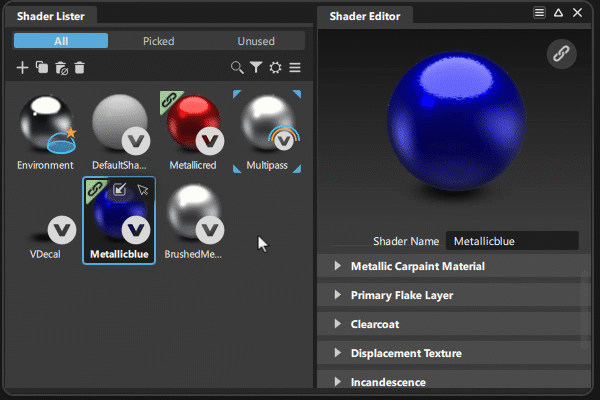
Working with VRED Environments
When you switch to the VRED Renderer and turn on Show Environment, the VRED default dome geometry and defaultEnvironment.hdr display in the scene. Use the VRED environment attributes to achieve the desired look of the environment.
You can add multiple environments to the Environment Editor list by dragging them from the Shader Library to the Shader Lister or by creating new ones. Select environments to quickly switch between them and present different lighting and background setups. This is especially useful when combined with Variants or if you use Live Referencing in your workflow.
Like material and shaders, environments get converted to render-specific versions when you switch between Alias and VRED render modes. This means that environments created in VRED render mode are not fully compatible in Alias render mode. When you create a Sphere Environment using the VRED Environment Editor and switch to Alias render mode, the .hdr image applied as Dome lighting in the VRED environment is automatically assigned as the Reflection Map in Alias. All other environment settings need to be adjusted to achieve the same look. Note that the VRED Skylight environment is not supported in Alias render mode.
The Environment attributes include Transform settings and in-canvas manipulators so that you can adjust the placement of the environment geometry, the .hdr image within the geometry, and the environment ground plane. Double-click the environment in the Shader Lister to adjust the attributes in the Environment Editor. For more information, see VRED Environment Settings.
Create a new environment
- Switch to VRED render mode.
- Open the Environment Editor.
- Click the More menu icon:
 then select Create Environment.
then select Create Environment. - Choose either Sphere Environment or Skylight.
- If you selected Sphere Environment, browse to the location of the .hdr image you want to use, then adjust the environment attributes.
- The new environment is created and becomes active in the scene. Switch between environments by selecting them in the list.
